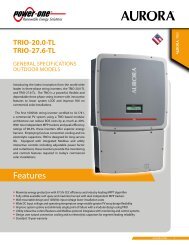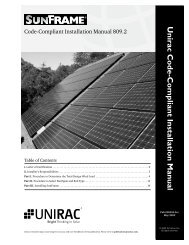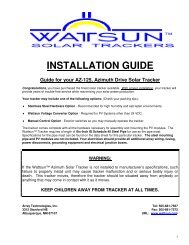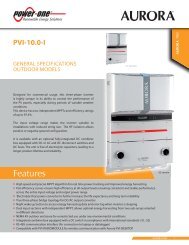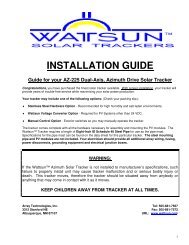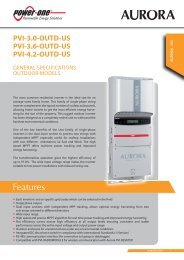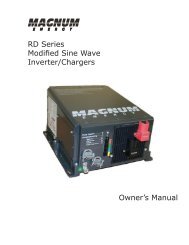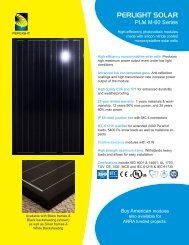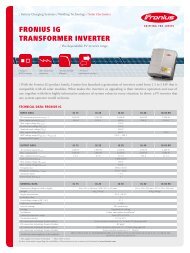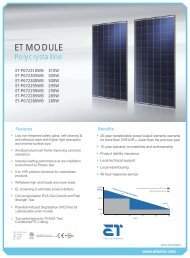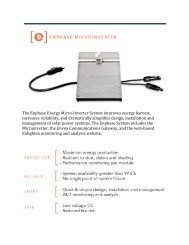MS Series Owner's Manual - Magnum Energy
MS Series Owner's Manual - Magnum Energy
MS Series Owner's Manual - Magnum Energy
Create successful ePaper yourself
Turn your PDF publications into a flip-book with our unique Google optimized e-Paper software.
Installation<br />
2.6.5 Neutral to Safety Ground Bonding<br />
The standards for safely wiring residential, commercial, RV/truck and marine installations in the<br />
United States require the neutral and safety ground be connected at the AC source; whether it is<br />
the utility feed in your home, an inverter, or a generator. This is to establish a specification that<br />
maximizes the possibility that a circuit breaker will activate if a hot-wire-to-ground fault occurs.<br />
These standards also require that the AC neutral be connected to safety ground (often called a<br />
bond) in one, and only one, place at any time. The single “bond” is established in order to make<br />
the electrical panel’s neutral line safe, by connecting it to ground. Without this bond, the neutral<br />
can have up to 60 VAC with respect to ground. On the other hand, if more than one bond is<br />
established, currents can circulate between neutral and ground and cause “ground-loop” currents.<br />
These “ground-loops” can trip GFCIs, cause an electric shock hazard and may be the reason for<br />
other annoying side effects.<br />
In applications where you are using an inverter as one of your AC sources along with another<br />
AC source (i.e., utility power or generator) there is the potential of having multiple connections<br />
(“bonds”) between neutral and ground. Therefore, you must ensure that the inverter does not also<br />
connect the neutral-to-ground while the other AC source is actively powering the inverter loads.<br />
This can be prevented if your inverter is equipped with automatic neutral-to-ground switching.<br />
WARNING: In most electrical systems, the neutral-to-ground “bond” is located in the<br />
main utility service entrance panel. Remove any “bond” downstream from the inverter<br />
to prevent multiple bonds. If there is an inverter subpanel - separate from a “main”<br />
electrical panel - it should have a removable wire that allows the neutral buss to be<br />
unbonded from the ground buss bar.<br />
All <strong>MS</strong> <strong>Series</strong> Inverter/Chargers have automatic neutral-to-ground switching to specifically work<br />
in multiple source applications. The <strong>MS</strong> <strong>Series</strong> inverters use an internal relay that automatically<br />
connects the AC neutral output terminal to the vehicle/boat’s ground while inverting (Inverter<br />
Mode) to provide the neutral-to-ground “bond”; as shown in figure 2-20. However, when an external<br />
AC source (i.e. shore power or a generator) is qualified, another neutral-to-ground connection is<br />
introduced in the system. When the <strong>MS</strong> <strong>Series</strong> is connected to this external AC source and goes<br />
into Standby Mode, the internal relay automatically opens the neutral-to-ground connection as<br />
shown in figure 2-21. This design keeps two neutral-to-ground connections from occurring at the<br />
same time, thereby preventing an electrical shock hazard between the vehicle/boat’s neutral and<br />
the external AC source’s neutral.<br />
Inside <strong>MS</strong> <strong>Series</strong> Inverter/Charger<br />
(Inverter Mode)<br />
Inside <strong>MS</strong> <strong>Series</strong> Inverter/Charger<br />
(Standby Mode)<br />
NEUT IN<br />
Neu-Gnd Relay (K1)<br />
NEUT IN<br />
Neu-Gnd Relay (K1)<br />
NEUT OUT<br />
NEUT OUT<br />
GROUND<br />
GROUND<br />
Neutral-to-Ground connection<br />
(inside AC compartment)<br />
Neutral-to-Ground connection<br />
(inside AC compartment)<br />
Figure 2-20, Neutral-to-Ground<br />
Connection (Inverter Mode)<br />
Figure 2-21, Neutral-to-Ground<br />
Connection (Standby Mode)<br />
© 2009 <strong>Magnum</strong> <strong>Energy</strong> Inc.<br />
Page 35




